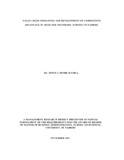| dc.description.abstract | The value chain is vital to the existence, sustenance and growth of an organization. The value chain system fundamentally affects the creation of products and services. It refers to a linkage of interrelated activities that go into developing the best value products and services by adding to the original inputs. Competitive advantage is the key to the organization having an edge over others. It is closely related to the value chain system and in fact derives from it. The activities in the value chain system may either be strengths or weaknesses for a company and these are what in turn determine whether that company will have a competitive advantage over its rivals. Secondary schools, like other organizations, need to evaluate their value chain systems and competitive advantage over other secondary schools. In general, a school's competitive advantage is indicated by its performance in the KCSE examination administered by the KNEC.
This study aims at determining the linkages of the value chain initiatives in selected secondary schools in Nairobi, as well as determining to what extent value chain activities contribute to competitive advantage in those schools. The research was based on a census survey aimed at identifying the value chain activities contributing to competitive advantage in secondary schools in Nairobi. Eighteen top-ranking secondary schools formed the population of study.
All of these offer the 8-4-4 system of education. Primary data collection was through questionnaires administered through a drop-and-pick-later method. The data thus collected was analyzed using measures of central tendency. From the fmdings of the research, it was evident that outbound logistics and operations are the most important factors in the facilitation of value chain analysis. Marketing and inbound logistics also feature prominently. In conclusion, it may be seen from the research findings that, secondary schools can stay competitive if they provide quality teaching and learning, provide guidance and counseling, and manage efficiency in service delivery. | en_US |

